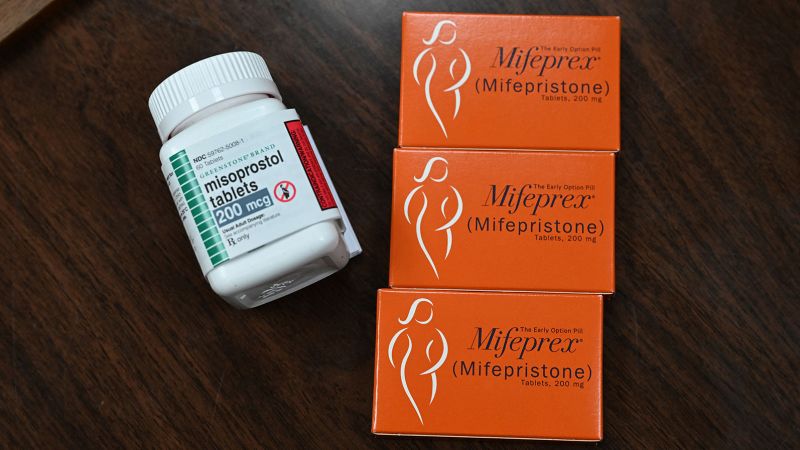

CNN
—
All eyes are on the Supreme Court as it could say at any moment before midnight Friday how it will handle a blockbuster medication abortion case that landed on its doorstep late last week.
The Supreme Court is deciding whether to let lower court rulings that would restrict access to a medication abortion drug go into effect. Justice Samuel Alito, who oversees emergency disputes in the region from where the lawsuit arises, has paused those rulings until midnight Friday, giving the court a two-day extension to consider the case. Final briefs in the case were filed overnight going into Wednesday morning.
The case is a challenge to the US Food and Drug Administration’s approach to regulating mifepristone, the first drug in the two-pill regimen used to terminate pregnancies in medication abortions.
At stake is what kind of access abortion-seekers will have to the drugs, even in states where abortion is widely permitted, as the lawsuit brought by anti-abortion activists moves forward. The case also raises wide-reaching questions about the authority courts have to second-guess the determinations by FDA experts about a drug’s safety.
Here is what to know about the order the Supreme Court is expected to hand down on Friday.
The Supreme Court has been asked by the federal government and a mifepristone manufacturer to put on hold lower court orders changing the FDA’s rules for use of the medication abortion drug.
The justices are reviewing a decision last week from the 5th US Circuit Court of Appeals ordering the FDA to reverse moves it’s made over the last seven years that have made mifepristone easier to obtain. The 5th Circuit said that FDA’s approval of mifepristone could stay in force, as it paused parts of a district court’s order that would have suspended that approval.
Mifepristone’s defenders have argued to the Supreme Court that even the 5th Circuit’s order returning the drug’s rules to the stricter, pre-2016 protocol would cause mass disruption, putting access to abortion pills in jeopardy. They have noted that following the 5th Circuit’s order would put the FDA at odds with a ruling earlier this month from a district judge in Washington state – in a separate case brought by Democratic attorneys general – that barred the FDA from taking any action that would reduce access to mifepristone in the 18 liberal jurisdictions behind that lawsuit, which seeks to expand access to the drug.
Anti-abortion doctors and medical associations argue that the FDA violated the law in how it went about approving mifepristone for abortions in 2000. They filed their lawsuit in November in Amarillo, Texas, where US District Judge Matthew Kacsmaryk – a Trump appointee who has previously issued major rulings against the Biden administration – was guaranteed to hear the case.
Kacsmaryk issued a sweeping ruling on April 7 that embraced the challengers’ arguments – which have been refuted by the mainstream medical community – that mifepristone was unsafe and halted the FDA’s 23-year-old approval of the pill.
The Biden administration, along with mifepristone manufacturer Danco Laboratories, took the dispute to the 5th Circuit, which issued an emergency order just before midnight on April 12. The 5th Circuit reinstated the drug’s approval, but said aspects of the lower court ruling that blocked the FDA’s more recent regulatory actions could go into effect.
Those actions include 2016 changes to mifepristone’s instructions that extended the window of use from seven to 10 weeks into the pregnancy, that reduced the number of in-person clinic visits required under the regimen from three to one, and that allowed non-doctors to administer the drug. The appeals court order also would reverse FDA’s later elimination of the requirement for in-person pick up of the drug– allowing it to be shipped to patients via the mail – as well as its 2019 approval of a generic version of mifepristone.
In filings with the Supreme Court, the Justice Department said that implementing those changes would “deny women lawful access to a drug FDA deemed a safe and effective alternative to invasive surgical abortion,” while putting the FDA and the entities it regulates “in an impossible position.”
The pill’s challengers, meanwhile, argue that the 5th Circuit’s ruling was a “reasonable order” and that the lower courts are justified in the actions they are taking against the FDA.
The anti-abortion lawsuit has arrived at the high court via its so-called shadow docket, the term for emergency disputes the justices deal with outside their formal calendar for hearing and deciding cases. The Supreme Court had not held a hearing in the medication abortion case, and the paper filings addressing the lower court rulings have been filed in an extremely expedited manner.
The next move by the Supreme Court could be just a one-line, unsigned order saying whether those lower court rulings can go into effect.
It’s also possible that the Supreme Court says that it will take up the case now for a formal review, stepping ahead of the appeals court, which is still in the process of fully reviewing the district judge’s decision.
The Justice Department and Danco asked the Supreme Court to put Kacsmaryk’s and the 5th Circuit’s orders on hold – effectively keeping the status quo around the drug’s regulations – while the appeal moves forward on the merits. The 5th Circuit has scheduled expedited briefing and a May 17 hearing as it fully reviews Kacsmaryk’s decision.
The Justice Department and Danco told the justices that alternatively, they could take up the case for review now, before the lower courts reach their final judgment.
The government’s opponents asked the high court to leave the lower court orders undisturbed. They said if the justices were to take up the case now, it should consider additional legal requests about how FDA went about approving the drug as well as whether the Comstock Act – an 1873 chastity law – allows for the mailing of abortion drugs.
Whether the Supreme Court takes up the case now or lets the lower court process play out, the dispute is almost guaranteed to get a more comprehensive review from the Supreme Court, which reversed national legal protections for abortion rights last year.
Beyond the implications for abortion, the medication abortion case also has consequences for what kind of authority and discretion the FDA has to determine a drug’s safety and appropriate rules for use.
While the conservative majority has generally been skeptical of executive branch power, it has deferred to FDA determinations in the past – specifically in a Trump-era dispute where the court sided with the FDA over challengers seeking looser rules for mifepristone’s administration.
This story has been updated with additional information.
